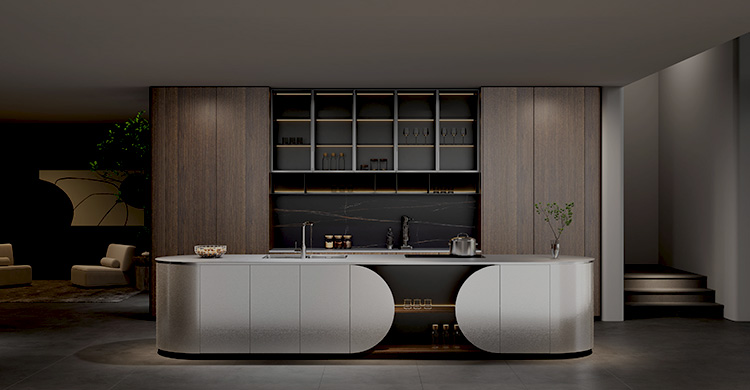Stainless steel has become a popular material for modern kitchen cabinets due to its corrosion resistance, ease of cleaning, and environmental friendliness. However, different types of stainless steel perform significantly differently in cabinet applications. This article will analyze the pros and cons of mainstream stainless steel types in cabinet manufacturing from a scientific perspective, helping consumers make informed decisions.
一、Basic Classification of Stainless Steel
Stainless steel can be divided into five categories based on its metallographic structure, with the following three being primarily used in cabinet manufacturing:
Austenitic Stainless Steel (300 Series):
Representative model 304(18%chromium + 8% nickel)
Ferritic Stainless Steel (400 Series):
Representative model 430 (16-18% chromium, no nickel)
Duplex Stainless Steel (2000 Series):
Representative model 2205 (22% chromium + 5% nickel + 3% molybdenum)
二、Comparison of Stainless Steel Types in Cabinet Applications
1. Austenitic Stainless Steel (304 Type)
Advantages:
Exceptional Corrosion Resistance: Nickel content effectively resists salt, acidic cleaners, and humid environments, making it suitable for coastal or high-humidity kitchens.
Food-Grade Safety: Lead-free and coating-free, it can directly contact food, complying with NSF standards in Europe and the US.
Excellent Ductility: Suitable for making custom-shaped cabinets (e.g., curved corners) without cracking after welding.
Disadvantages:
High Cost: Nickel price fluctuations make it 30-50% more expensive than 430 steel.
Low Hardness: Mohs hardness of 5.5 makes it prone to scratches, requiring brushed finishes (Ra0.4-0.8μm) to mask marks.
Cold Touch: Requires underfloor heating or wooden countertops for winter use.
Typical Applications: High-end integrated cabinets, laboratory workbenches, commercial kitchen equipment.
2.Ferritic Stainless Steel (430 Type)
Advantages:
Cost-Effective: Nickel-free, priced at 60-70% of 304 steel.
Magnetic Properties: Allows direct attachment of magnetic storage accessories, improving space utilization.
Uniform Heat Conduction: Suitable for integrated induction cooktops.
Disadvantages:
Limited Corrosion Resistance: Prone to pitting in chloride environments (e.g., long-term exposure to seafood).
Difficult Processing: Cold working may cause "orange peel effect," requiring additional polishing.
Welding Discoloration: Welds tend to blacken, often requiring hidden welding techniques.
Typical Applications: Budget-friendly cabinets, dry-area cabinets, magnetic functional accessories.
3. Duplex Stainless Steel (2205 Type)
Advantages:
Double Strength: Yield strength of 450MPa, twice that of 304 steel, allowing ultra-thin cabinets (1.2mm).
Chloride Ion Resistance: Suitable for seafood processing areas or near disinfection cabinets.
Stress Corrosion Resistance: Prevents micro-cracks under long-term load.
Disadvantages:
High Cost: Priced 3-5 times higher than 304 steel, used only for special requirements.
High Processing Threshold: Requires laser cutting and argon arc welding equipment.
Grayish Color:Lacks traditional stainless steel's metallic luster, requiring special surface treatment.
Typical Applications:Yacht kitchens, medical disinfection cabinets, seafood processing tables.
三、Impact of Processing Details on Performance
Surface Treatment Techniques:
Mirror Polishing (8K): Reflectivity >90%, but requires monthly waxing.
Embossing: 0.1-0.3mm deep patterns, improving scratch resistance by 40%.
PVD Coating: Titanium coating increases hardness to HV800,close to the sapphire level.
Structural Reinforcement Solutions:
Honeycomb Aluminum Filling: Reduces weight while enhancing deformation resistance (load capacity up to 150kg/m²).
Silicone Sealing Strips: Eliminates noise caused by thermal expansion and contraction of cabinet doors.
四、Purchasing Recommendations
Coastal Homes: Prefer 304 stainless steel with electrolytic coloring; consider 2205 for higher budgets.
Small Kitchens: Combine 430-type cabinets with 304-type countertops for cost-effectiveness.
Minimalist Style: Choose 304 steel with 2B cold-rolled surface (matte gray) to avoid fingerprint marks.
Smart Kitchens: Prioritize 430-type for magnetic properties, facilitating smart module installation.
五、Future Trends
Antibacterial Stainless Steel: Adding 1.5% copper achieves >99.9% E. coli eradication.
Self-Healing Coatings: Microcapsule technology releases repair substances at scratch sites.
Composite Structures: 3D-printed titanium-stainless steel gradient materials combine lightweight and high strength.
Through scientific material selection and innovative processing, stainless steel cabinets are evolving beyond their traditional "industrial" image, moving towards intelligence and artistic designs. Consumers should choose based on specific usage scenarios.




